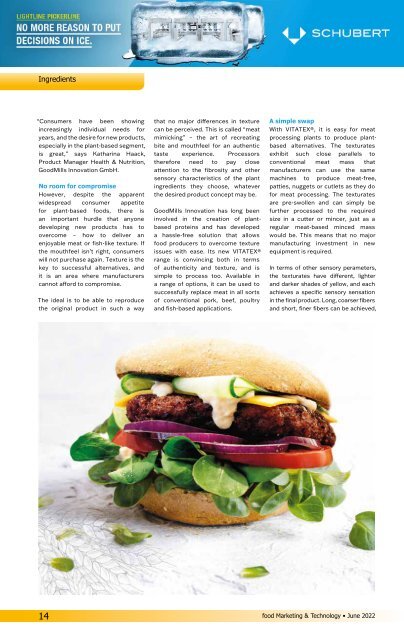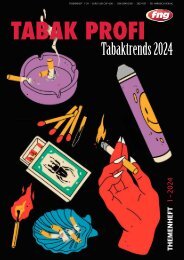food Marketing & Technology 3/2022
food Marketing & Technology is the international magazine for executives and specialists in the food industry.
food Marketing & Technology is the international magazine for executives and specialists in the food industry.
- No tags were found...
You also want an ePaper? Increase the reach of your titles
YUMPU automatically turns print PDFs into web optimized ePapers that Google loves.
Ingredients<br />
“Consumers have been showing<br />
increasingly individual needs for<br />
years, and the desire for new products,<br />
especially in the plant-based segment,<br />
is great,” says Katharina Haack,<br />
Product Manager Health & Nutrition,<br />
GoodMills Innovation GmbH.<br />
No room for compromise<br />
However, despite the apparent<br />
widespread consumer appetite<br />
for plant-based <strong>food</strong>s, there is<br />
an important hurdle that anyone<br />
developing new products has to<br />
overcome – how to deliver an<br />
enjoyable meat or fish-like texture. If<br />
the mouthfeel isn’t right, consumers<br />
will not purchase again. Texture is the<br />
key to successful alternatives, and<br />
it is an area where manufacturers<br />
cannot afford to compromise.<br />
The ideal is to be able to reproduce<br />
the original product in such a way<br />
that no major differences in texture<br />
can be perceived. This is called “meat<br />
mimicking” – the art of recreating<br />
bite and mouthfeel for an authentic<br />
taste experience. Processors<br />
therefore need to pay close<br />
attention to the fibrosity and other<br />
sensory characteristics of the plant<br />
ingredients they choose, whatever<br />
the desired product concept may be.<br />
GoodMills Innovation has long been<br />
involved in the creation of plantbased<br />
proteins and has developed<br />
a hassle-free solution that allows<br />
<strong>food</strong> producers to overcome texture<br />
issues with ease. Its new VITATEX®<br />
range is convincing both in terms<br />
of authenticity and texture, and is<br />
simple to process too. Available in<br />
a range of options, it can be used to<br />
successfully replace meat in all sorts<br />
of conventional pork, beef, poultry<br />
and fish-based applications.<br />
A simple swap<br />
With VITATEX®, it is easy for meat<br />
processing plants to produce plantbased<br />
alternatives. The texturates<br />
exhibit such close parallels to<br />
conventional meat mass that<br />
manufacturers can use the same<br />
machines to produce meat-free,<br />
patties, nuggets or cutlets as they do<br />
for meat processing. The texturates<br />
are pre-swollen and can simply be<br />
further processed to the required<br />
size in a cutter or mincer, just as a<br />
regular meat-based minced mass<br />
would be. This means that no major<br />
manufacturing investment in new<br />
equipment is required.<br />
In terms of other sensory perameters,<br />
the texturates have different, lighter<br />
and darker shades of yellow, and each<br />
achieves a specific sensory sensation<br />
in the final product. Long, coarser fibers<br />
and short, finer fibers can be achieved,<br />
14 <strong>food</strong> <strong>Marketing</strong> & <strong>Technology</strong> • June <strong>2022</strong>


















